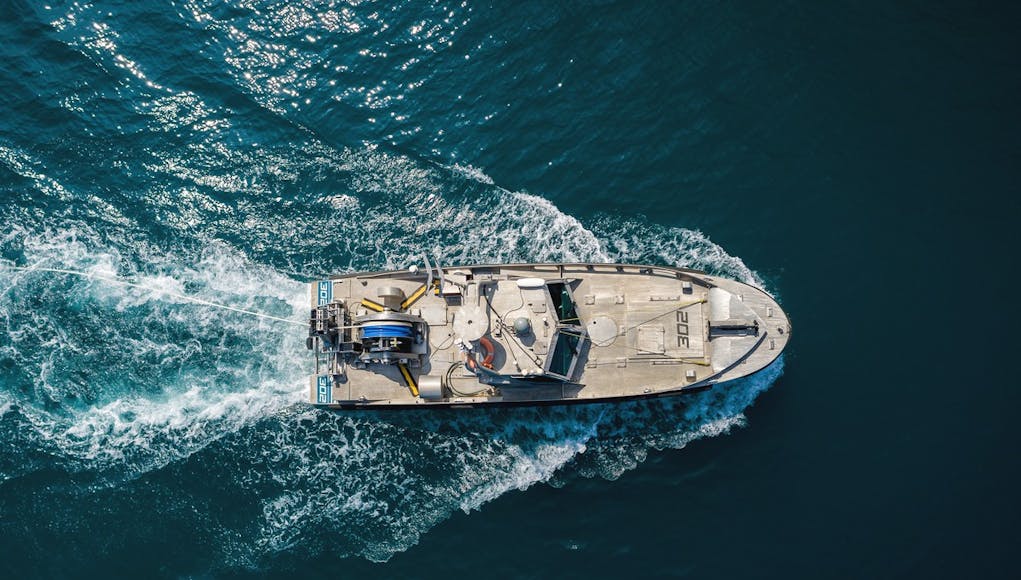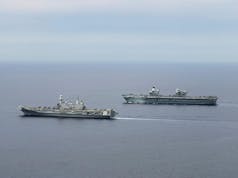Elbit Systems UK say it has completed a series of Anti-Submarine Warfare trials with the MoD.
The firm say that the trials were delivered via Dstl’s (Defence Science and Technology Laboratory) Progeny Framework, exploring how autonomous systems could support future ASW operations.
“Elbit Systems UK was one of a shortlist of UK companies selected to take part in this second phase of the project – a series of live at sea trials which took place off UK coast with the Ministry of Defence in late October 2019. Elbit Systems UK used its Seagull USV (Unmanned Surface Vehicle) for these trials, with the USA’s L3 Harris providing the sonar. Seagull, Elbit System’s multi-mission, multi-sensor USV demonstrated her autonomous ASW utility to the UK MoD, across the entire trials period, utilising her ‘ASW Toolbox’ solution throughout to show how the abilities of this system to offer a force multiplier for ASW operations.”
Martin Fausset, CEO of Elbit Systems UK, said:
“Elbit Systems has world leading technology to offer to the maritime and littoral environment. The Seagull USV has once again, demonstrated its superior capabilities underlining Elbit Systems UK’s competitive position to providing innovative and cost-effective solutions to the UK Armed Forces. We are proud of our ongoing work with the Royal Navy as we work together to maintain its operational advantage.”
About Seagull
On their website, Elbit say that the Seagull Unmanned Surface Vessel has multi-mission capability, being able to perform Anti-Submarine Warfare (ASW), Mine Counter Measures (MCM), Electronic Warfare (EW), Maritime Security (MS), Hydrography and other missions using the same vessels, mission control system and data links.
“Meanwhile its Anti-Submarine Warfare (ASW) capability provides the navy with a tactical advantage by deterring and threatening enemy submarines using an available asset with significantly lower risk. Seagull’s Mine Counter Measures (MCM) capability facilitates end-to-end mine hunting operations including detection, classification, localisation, identification and neutralisation of bottom, moored and drifting sea mines. The Seagull is deployable with capability to operate from port or mother-ship, with two vessels able to be controlled from the same MCS (Mission Control System) and both manned and unmanned modes of operation, the latter featuring a high level of autonomy.
Seagull offers endurance of 4 days and mission sea-keeping of up to Sea-State 5. Seagull has previously participated in bi-national MCM trials in the North Sea off the Belgian Coast organised by the Directorate General of Material Resources (DGMR) of the Belgian Defence Ministry, and has been used in a series of demonstrations alongside several global navies, including being deployed in 2018 by NATO forces in a joint ASW exercise alongside the Royal Navy’s Type 45 HMS Duncan and the Spanish Navy’s Santa Maria-class frigate Victoria.”














Results sent straight to Israel for further analysis.
Well it is an Israeli company after all. lol
Well the RN get to know that tech, so what is the issue?
I still hope T31 gets a sonar but if not hopefully it can at least carry a couple of these or something similar
Is a bow sonar useful for T31 though in tomorrows threat environment? If listening passively then is the ship quiet enough to detect modern sub threats, it seems unlikely even if T31 does meet the NATO ASW noise requirements. If the sonar is active then the ship is advertising exactly where it is, which would be likely to make it easier to attack.
The better option IMO is a combination of USV and UAV assets from T31, operated at distance from the ship and much more quiet. The USV do what is illustrated in this article while UAV can drop sonabuoys. Perhaps use a Wildcat for torpedo launch rather than the USV. I still like the idea of an optional fit to add FLASH dipping sonar to Wildcat as the ROK navy have done.
A question I have regarding T31 and USV is the size of the boat bays and the ability to host one or more 11/12m USVs.
A bow sonar is always useful.
Even though it has limited Passive capabilities it is still OK.
Yes you can be seen more easily when active but the range of modern sonars in active mode is well over 50K yards so its handy for keeping a sub at bay. The modern algorithms and processing power do all the hard work for you. Classification, range speed profile course are all done by the computer.
Regarding the Seagull…its probably OK in the littoral… It would struggle in the open ocean with a bit of roughers. And you still have the Data Link Bandwidth issue. ASW data takes a lot of processing power to sift through it. You will need a big big Data Link Pipe to push it through.
Always appreciate the feedback GB. I’ve seen Seagull described as operational in Sea State 4 and surviving Sea State 7, or as this article states operational in Sea State 5, so USV ASW definitely has practical limits based on craft such as Seagull or with the similar Atlas Electronik ARCIMS solution. Although to be fair, both seem to be primarily pitched at littoral ops.
In an ideal world T31 might have bow and towed sonar like T26. But if it had only one then a towed Captas 2, or even just Captas 1, class solution seems more appealing, albeit again constrained to Sea State 6 ops. So perhaps towed solutions are better left to the USV, although a combination of both for muli-static operation is attractive. A bow sonar does provide deterrence for conditions beyond SS 5/6.
It is interesting to reflect that for all the wide disparagement that the T31 program has received, it might end up being the light frigate the USN should have had for their LCS role, instead of focusing so much on speed to the detriment of other capabilities in their current platforms.
This is all still new tech. If it is cost effective and they are actually any good, then larger platforms can be explored to handle rougher seas. If similar could be designed with a radar for creating a picket it could be a major force multiplier for a carrier group.
The USN seem to be in favour of developing a force of larger unmanned vessels that might handle higher sea states but there’s still a sea state limit for towed sonar in ASW applications. In addition we’re then talking about solutions that are no longer deployable from a mothership, such as a T31. So certainly viable but a different class of capability, with different requirements if they are in the water all the time.
For the CSG radar pickets, I’d expect a combination of Crowsnest, the Merlin/Wildcat standard surveillance radars and the F35B to provide the radar picture at distance for surface threats. The other issue with adding radar to a USV is that you now need a vessel large enough to be able to power the radar and position it at height to increase the radar horizon. In other words you’re probably looking at an unmanned OPV class vessel that has to be able to keep up with the CSG.
https://www.defensenews.com/naval/2019/12/21/the-us-navy-gets-its-large-unmanned-surface-vessels-in-2020-with-strings-attached/
Yeah, maybe if this craft was a semi submersible maybe it could deal better with sea state.
Here’s a thought, the T31 blasting away on a mediocre sonar attracts the attention of an enemy sub. Meanwhile back on the ship. The USV operator has noticed an interesting signature on one of the deployed unmanned subs. The Wildcat is sent to drop some good news on the sub.
Perhaps having a noisy ship isn’t such a disadvantage if it’s hosting some quiet unmanned subs? Still a long road before they can be operational though!
When on a RN LPD during a CASEX in the SW approaches the sub who was playing with the ASW group thought we where a ferry returning from Santander and ignored us…So noisy is sometimes good!
The Seagull USV is armed with a remote control weapon system mounted with a 12.7mm machine gun. The torpedo launching system aboard the vessel allows the firing of torpedoes against hostile submarines and ensures the protection of naval assets, critical sea areas and high-value assets from submarines. The USV also incorporates a non-lethal weapon system.
Why did you delete my comment? it was a link to the web page of the company that makes the USV mounted sonar shown in the photo at the top of this post and gives more detail than you do.
Promising approach. But, as it is new, I think try-and-error is inevitable. On this regard, “starting small” will be good. As there are many 12m-class USV, and at least in MCM role, they are already going on (e.g. Dutch/Belgium), starting with 12-m class USV is the way to go.
If anything happen, we can convert it to support MCM role in future. Or, we can just start as a “MCM-USV with its mission system replaced with ASW-kits”.
As ASW is “awesomely-slow”, carrying torpedo may not be important (it may be, but it will be known only after extensive trials). This choice makes the system more simple (“man-in-the loop to fire” issue etc.), more light weight, and more “similar to MCM-USVs”.
I think RN shall start procuring its “1st generation” of ASW-USVs with 12m-USV options as soon as possible. How about starting with purchasing 10 units, to form three “3-unit-systems” + 1 in maintenance?